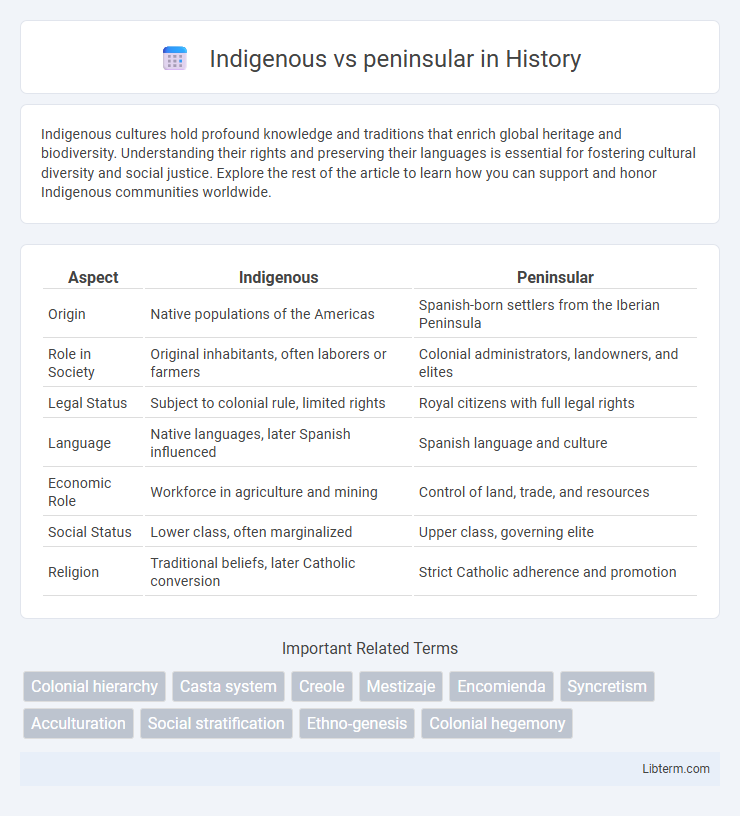Indigenous cultures hold profound knowledge and traditions that enrich global heritage and biodiversity. Understanding their rights and preserving their languages is essential for fostering cultural diversity and social justice. Explore the rest of the article to learn how you can support and honor Indigenous communities worldwide.
Table of Comparison
| Aspect | Indigenous | Peninsular |
|---|---|---|
| Origin | Native populations of the Americas | Spanish-born settlers from the Iberian Peninsula |
| Role in Society | Original inhabitants, often laborers or farmers | Colonial administrators, landowners, and elites |
| Legal Status | Subject to colonial rule, limited rights | Royal citizens with full legal rights |
| Language | Native languages, later Spanish influenced | Spanish language and culture |
| Economic Role | Workforce in agriculture and mining | Control of land, trade, and resources |
| Social Status | Lower class, often marginalized | Upper class, governing elite |
| Religion | Traditional beliefs, later Catholic conversion | Strict Catholic adherence and promotion |
Introduction: Defining Indigenous and Peninsular
Indigenous refers to the native peoples originally inhabiting a region before colonization, characterized by distinct cultural, linguistic, and historical identities. Peninsular denotes individuals born in the Iberian Peninsula who migrated to colonial territories, often holding higher social and administrative status. Understanding these terms is crucial for analyzing colonial social hierarchies and cultural dynamics.
Historical Context and Origins
Indigenous peoples, often referred to as Native or First Nations, represent the original inhabitants of a region with distinct cultural, linguistic, and social traditions predating colonial contact. Peninsular populations trace their origins to settlers or colonizers from the Iberian Peninsula, primarily Spain and Portugal, during the Age of Exploration and subsequent colonial periods. The historical context highlights the complex dynamics of cultural exchange, conflict, and syncretism resulting from interactions between Indigenous communities and Peninsular colonizers.
Cultural Differences and Traditions
Indigenous cultures emphasize ancestral customs, oral traditions, and spiritual connections to land, shaping vibrant ceremonies and community rituals unique to each tribe. Peninsular societies reflect European colonial influences with hierarchical social structures, formalized religious practices, and Eurocentric art forms. Distinct language use, dress, and festive celebrations highlight the profound cultural divergence between Indigenous peoples and peninsular descendants.
Language and Communication Styles
Indigenous languages in the Philippines, such as Cebuano, Ilocano, and Tagalog, are rooted in native cultural expressions and community identity, while Peninsular Spaniards primarily spoke Castilian Spanish, influencing formal education and government communication. Indigenous communication styles often emphasize indirectness, non-verbal cues, and storytelling, reflecting communal values, whereas Peninsular communication is generally more direct and structured, adhering to European social norms. This linguistic and communicative contrast shaped social interactions and cultural integration during Spanish colonization.
Social Structures and Community Life
Indigenous communities maintain social structures deeply rooted in kinship, communal land ownership, and collective decision-making, emphasizing reciprocity and spiritual connections to the environment. Peninsular societies, influenced by European hierarchies, often feature rigid class divisions, centralized authority, and individual land ownership, limiting social mobility. Indigenous social life fosters inclusive participation and mutual support, contrasting with the more stratified, often exclusionary nature of peninsular community relations.
Economic Roles and Contributions
Indigenous populations primarily engaged in agriculture, artisanal crafts, and local trade, forming the backbone of the colonial economy through subsistence farming and resource extraction. Peninsular Spaniards dominated administrative, commercial, and military positions, controlling large estates, mining operations, and dictating colonial economic policies. The economic hierarchy established during the colonial period entrenched disparities, with Indigenous labor exploited to sustain Peninsular wealth and metropolitan commerce.
Political Influence and Representation
Indigenous populations in many regions often face significantly lower political influence and underrepresentation compared to peninsular or settler-descendant groups, despite constituting a substantial portion of the population. Political systems frequently marginalize Indigenous voices through limited access to leadership roles and decision-making platforms, resulting in policies that inadequately address their rights and needs. Efforts to improve Indigenous representation focus on legal reforms, enhanced electoral participation, and recognition of indigenous governance structures within national political frameworks.
Religion, Beliefs, and Practices
Indigenous religious beliefs centered on animism, ancestor worship, and the sacredness of nature, with rituals often conducted by shamans or spiritual leaders to maintain harmony with the natural and spiritual worlds. Peninsular colonizers introduced Catholicism, enforcing the conversion of indigenous populations through mission churches, sacraments, and the suppression of native spiritual practices. The resulting syncretism blended indigenous symbols with Christian rites, creating unique religious expressions that persist in many Latin American communities today.
Contemporary Issues and Challenges
Indigenous communities face ongoing challenges related to land rights, cultural preservation, and systemic inequality, often exacerbated by government policies favoring peninsular populations. Peninsular groups typically hold more political power and economic resources, leading to disparities in access to education, healthcare, and employment opportunities. Contemporary debates emphasize the need for legal reforms and social programs that address historical injustices and promote Indigenous autonomy and cultural revitalization.
Pathways to Unity and Mutual Understanding
Indigenous and Peninsular communities often navigate complex histories marked by colonization, cultural disparities, and social hierarchies, yet efforts emphasizing respectful dialogue and collaborative projects foster pathways to unity and mutual understanding. Embracing Indigenous knowledge systems alongside Peninsular perspectives encourages shared narratives and reconciliatory practices, essential for dismantling stereotypes and addressing historical grievances. Initiatives such as intercultural education programs and joint community development initiatives serve as vital mechanisms bridging divides and promoting inclusive identities.
Indigenous Infographic

 libterm.com
libterm.com